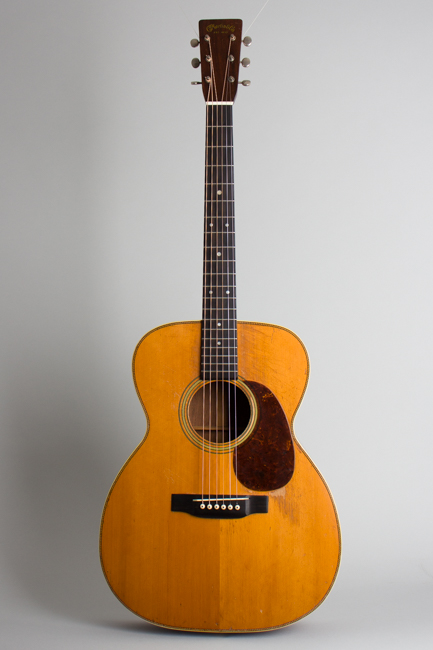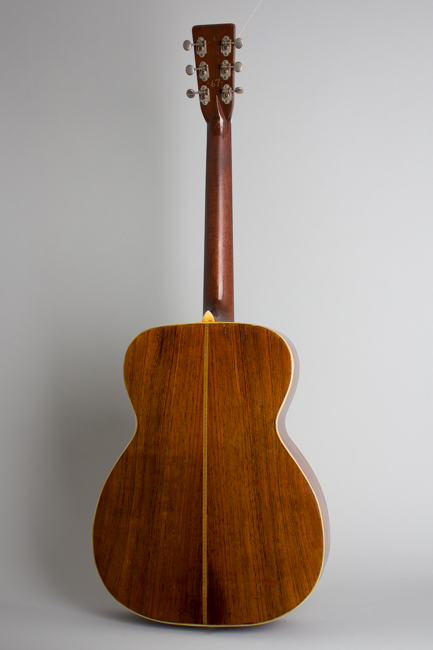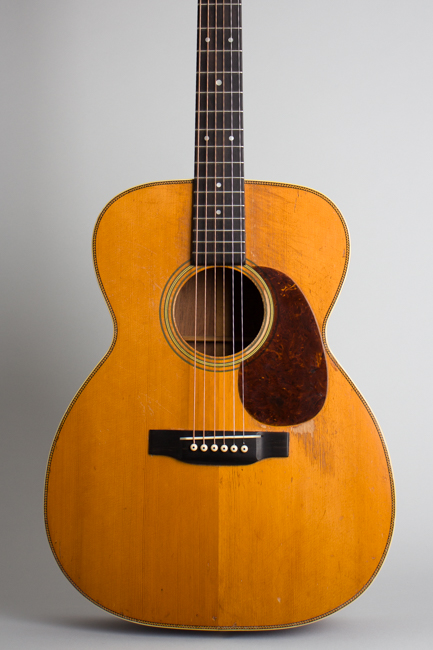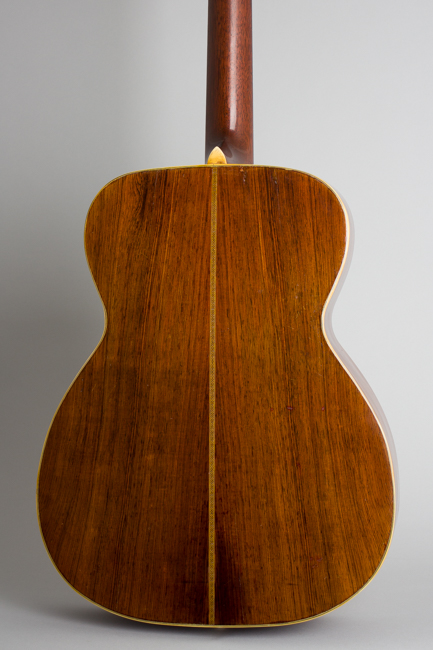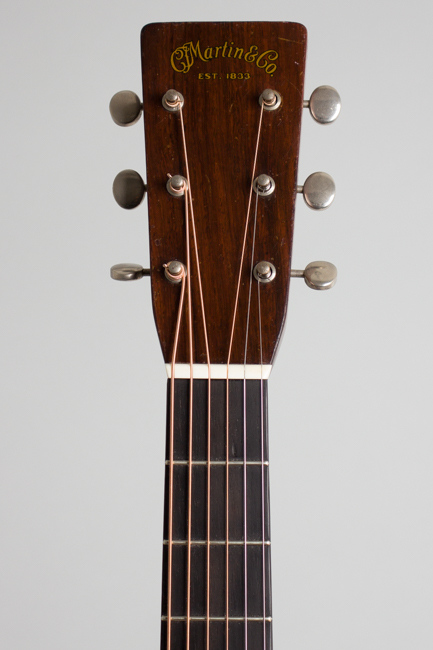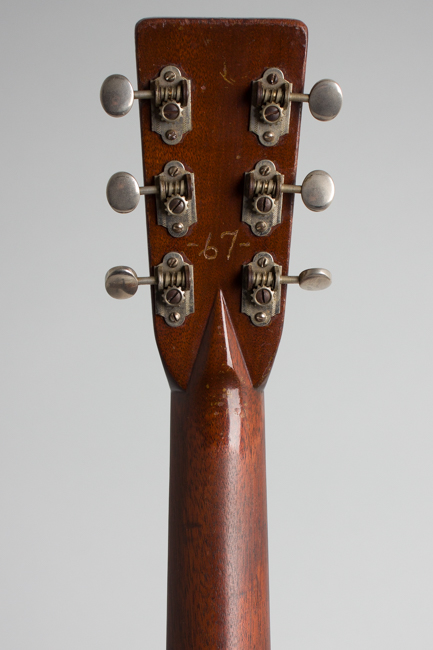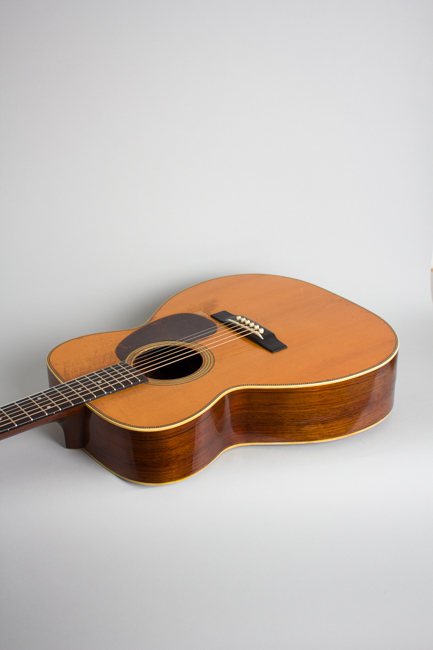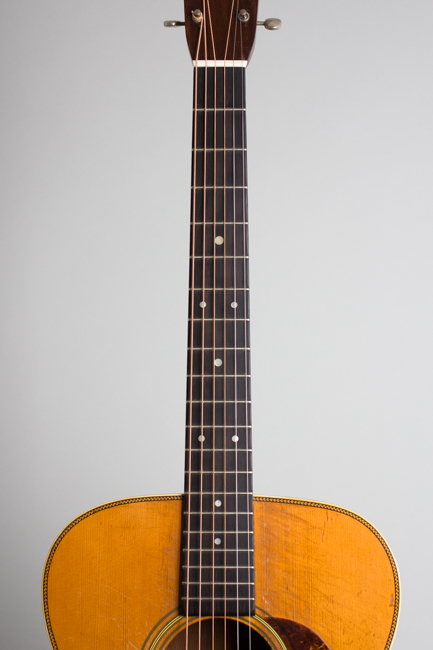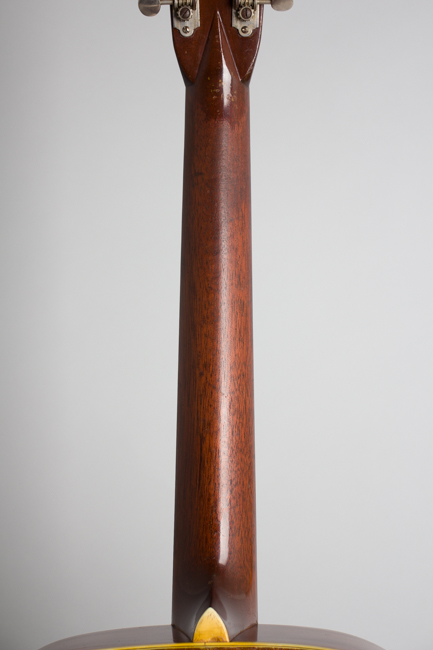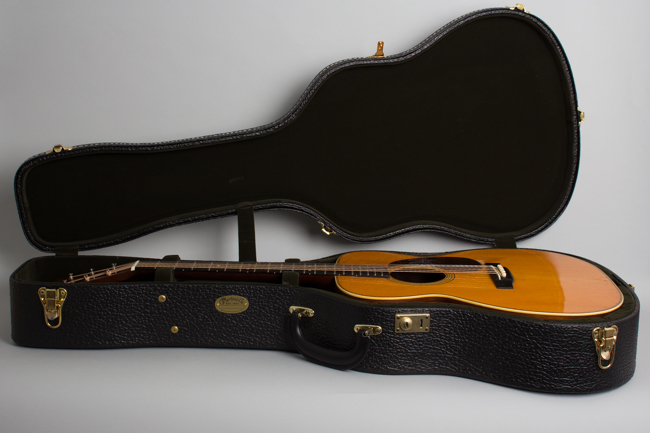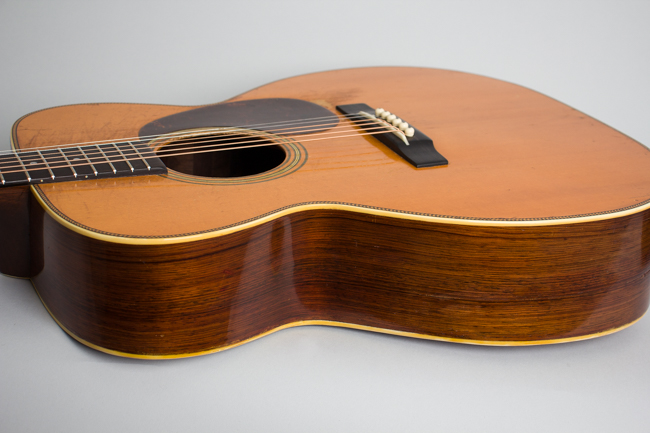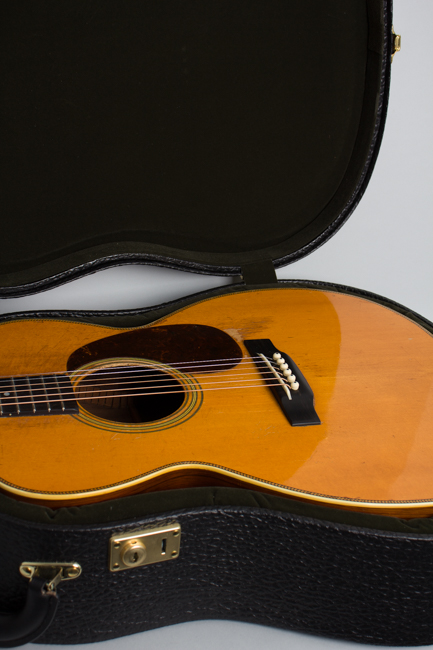C. F. Martin 000-28 Flat Top Acoustic Guitar (1945)
This item has been sold.
Item # 11207
Prices subject to change without notice.
C. F. Martin 000-28 Model Flat Top Acoustic Guitar (1945), made in Nazareth, PA, serial # 93168, natural lacquer finish, Brazilian rosewood back and sides, spruce top; mahogany neck with ebony fingerboard, black tolex hard shell case.
This is a well-played JUST postwar Martin 000-28 made at the end of 1945; It would have shipped out as the US was starting to shift to peacetime footing. There is some old repair work most notably to the upper side on this one that is not the most attractive, but nothing that affects the guitar sonically or playability-wise.
The 14 fret "herringbone" 000-28 is to some players the perfect flat-top. The 15" wide narrow-waisted body is just over 1/2" smaller than a Dreadnought so yields a somewhat more focused midrange sound with a less dominant bass. By late 1945 the top is no longer scallop-braced top but is still not as heavily built as later 1950s examples, offering considerable power when pushed combined with sweetness, sparkle, and a singing character even when played softly. The scale is slightly shorter than the earlier 1930s OM model making the action a bit more supple.
This 000 shows transitional period appointments. The back and sides are Brazilian rosewood with even straight-grain figure on the sides and a slightly diagonally run grain on the back with some additional figuring near the top edges. The top is tight-grained spruce, bordered with the famous "herringbone" wood trim that defines the Style 28 models and bound with ivory celluloid. "Herringbone" would disappear from Martins for more than a generation not long after this guitar was made. The back is triple-bound in celluloid with a zip-zag pattern backstrip. Other features include the long-saddle ebony bridge, multiple celluloid sound hole rings and tortoise celluloid pickguard.
The neck is mahogany with an unbound ebony fingerboard with mixed-size pearl dot inlay. The steel "T" bar truss rod is present, re-instated after wartime examples substituted an ebony reinforcement. The peghead is faced in Brazilian rosewood with the gold "C.F. Martin & Co." decal at the top. The neck has a rounded soft "V" profile, a bit chunkier than many wartime necks. The nut is nominally a 1 11/16" width; this one is actually slightly slimmer at a hair over 1 5/8", worn down slightly on the treble side. The tuners are individual Waverly openbacks from the 1950's, not original but on for a long time now!
Rosewood 000s from this period are far from common guitars. Only 147 000-28s were produced in 1945, a small total by modern standards. This 000-28 is a real survivor with the smooth and powerful sound typical of original "Golden Age" Martins, perfect for styles vintage or contemporary, a fantastic recording guitar. While not perfectly preserved it is an excellent player ready for many more decades of use.
Overall length is 39 3/4 in. (101 cm.), 15 1/8 in. (38.4 cm.) wide at lower bout, and 4 1/8 in. (10.5 cm.) in depth at side, taken at the end block. Scale length is 24 3/4 in. (629 mm.). Width of nut is 1 5/8 in. (41 mm.).
This 000 shows overall wear and tear and like many of these often hard-worked guitars has had some notable repair. In this case a large crack on the upper side running from waist to endpin was repaired many decades ago, solidly sealed but frankly fairly ugly to look at. The wood is uneven in spots, with some patching in a couple of places at the turn of the bout and a decent amount of topical touch-up. Beneath this, a piece of mahogany was installed all along the inner side from waist to endblock to reinforce the entire area. The back was removed for this work, and put back on for the most part fairly neatly. All this looks to have been done many decades ago; it is not how we would approach such a repair now, but is completely solid at least.
Except for the topical touch ups related to this work the finish is original and shows worn down areas, dings, dents and scrapes overall. The top has scratches, dings and dents with larger areas of finish loss from picking around the lower sound hole rim, above and below the fingerboard extension, in between the pickguard and bridge and most heavily off the back edge of the pickguard. The back of the neck is fairly heavily worn down to the wood, particularly on the treble side.
Apart from the side repair there are two cracks to the back just off the neck block, possibly related to the back removal; these are short but sealed with a visible heavy touch-up. A third split below the block is cleanly sealed without any added finish. One other sealed split is visible just above the backstrip off the endblock. Amazingly enough through all this the top never suffered any cracks at all.
The neck has been reset, with the fingerboard trued and nicely refretted with period correct wire. The bridge has been replaced with an excellent replica; there are a few small marks around the perimeter. Internally the top is clean and undisturbed, including all the original bracing and small maple bridge plate. There are some small breaks in the kerfing along the back, and of course that large added wood underlay on the upper side. The tuners were probably replaced in the 1950s with no reaming and those old Waverlys are still in place. For some reason "67" is neatly etched in the back of the peghead.
While far from a perfect example, this rosewood 000 is still in more original condition than many from this period, and a fine player with the fantastic sound one would expect. Herringbone Martins of this type are often heavily used and hard to find in anything like original condition. This survivor shows its scars but is full of great songs and stories. It is housed in a well fitted modern HSC. Overall Very Good + Condition.
This is a well-played JUST postwar Martin 000-28 made at the end of 1945; It would have shipped out as the US was starting to shift to peacetime footing. There is some old repair work most notably to the upper side on this one that is not the most attractive, but nothing that affects the guitar sonically or playability-wise.
The 14 fret "herringbone" 000-28 is to some players the perfect flat-top. The 15" wide narrow-waisted body is just over 1/2" smaller than a Dreadnought so yields a somewhat more focused midrange sound with a less dominant bass. By late 1945 the top is no longer scallop-braced top but is still not as heavily built as later 1950s examples, offering considerable power when pushed combined with sweetness, sparkle, and a singing character even when played softly. The scale is slightly shorter than the earlier 1930s OM model making the action a bit more supple.
This 000 shows transitional period appointments. The back and sides are Brazilian rosewood with even straight-grain figure on the sides and a slightly diagonally run grain on the back with some additional figuring near the top edges. The top is tight-grained spruce, bordered with the famous "herringbone" wood trim that defines the Style 28 models and bound with ivory celluloid. "Herringbone" would disappear from Martins for more than a generation not long after this guitar was made. The back is triple-bound in celluloid with a zip-zag pattern backstrip. Other features include the long-saddle ebony bridge, multiple celluloid sound hole rings and tortoise celluloid pickguard.
The neck is mahogany with an unbound ebony fingerboard with mixed-size pearl dot inlay. The steel "T" bar truss rod is present, re-instated after wartime examples substituted an ebony reinforcement. The peghead is faced in Brazilian rosewood with the gold "C.F. Martin & Co." decal at the top. The neck has a rounded soft "V" profile, a bit chunkier than many wartime necks. The nut is nominally a 1 11/16" width; this one is actually slightly slimmer at a hair over 1 5/8", worn down slightly on the treble side. The tuners are individual Waverly openbacks from the 1950's, not original but on for a long time now!
Rosewood 000s from this period are far from common guitars. Only 147 000-28s were produced in 1945, a small total by modern standards. This 000-28 is a real survivor with the smooth and powerful sound typical of original "Golden Age" Martins, perfect for styles vintage or contemporary, a fantastic recording guitar. While not perfectly preserved it is an excellent player ready for many more decades of use.
Overall length is 39 3/4 in. (101 cm.), 15 1/8 in. (38.4 cm.) wide at lower bout, and 4 1/8 in. (10.5 cm.) in depth at side, taken at the end block. Scale length is 24 3/4 in. (629 mm.). Width of nut is 1 5/8 in. (41 mm.).
This 000 shows overall wear and tear and like many of these often hard-worked guitars has had some notable repair. In this case a large crack on the upper side running from waist to endpin was repaired many decades ago, solidly sealed but frankly fairly ugly to look at. The wood is uneven in spots, with some patching in a couple of places at the turn of the bout and a decent amount of topical touch-up. Beneath this, a piece of mahogany was installed all along the inner side from waist to endblock to reinforce the entire area. The back was removed for this work, and put back on for the most part fairly neatly. All this looks to have been done many decades ago; it is not how we would approach such a repair now, but is completely solid at least.
Except for the topical touch ups related to this work the finish is original and shows worn down areas, dings, dents and scrapes overall. The top has scratches, dings and dents with larger areas of finish loss from picking around the lower sound hole rim, above and below the fingerboard extension, in between the pickguard and bridge and most heavily off the back edge of the pickguard. The back of the neck is fairly heavily worn down to the wood, particularly on the treble side.
Apart from the side repair there are two cracks to the back just off the neck block, possibly related to the back removal; these are short but sealed with a visible heavy touch-up. A third split below the block is cleanly sealed without any added finish. One other sealed split is visible just above the backstrip off the endblock. Amazingly enough through all this the top never suffered any cracks at all.
The neck has been reset, with the fingerboard trued and nicely refretted with period correct wire. The bridge has been replaced with an excellent replica; there are a few small marks around the perimeter. Internally the top is clean and undisturbed, including all the original bracing and small maple bridge plate. There are some small breaks in the kerfing along the back, and of course that large added wood underlay on the upper side. The tuners were probably replaced in the 1950s with no reaming and those old Waverlys are still in place. For some reason "67" is neatly etched in the back of the peghead.
While far from a perfect example, this rosewood 000 is still in more original condition than many from this period, and a fine player with the fantastic sound one would expect. Herringbone Martins of this type are often heavily used and hard to find in anything like original condition. This survivor shows its scars but is full of great songs and stories. It is housed in a well fitted modern HSC. Overall Very Good + Condition.
